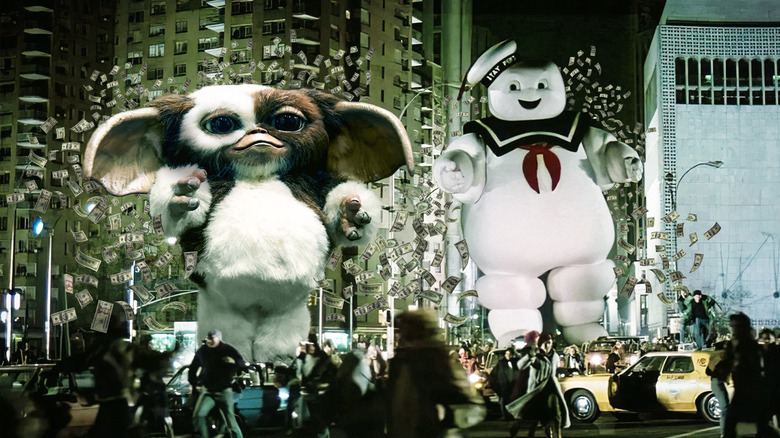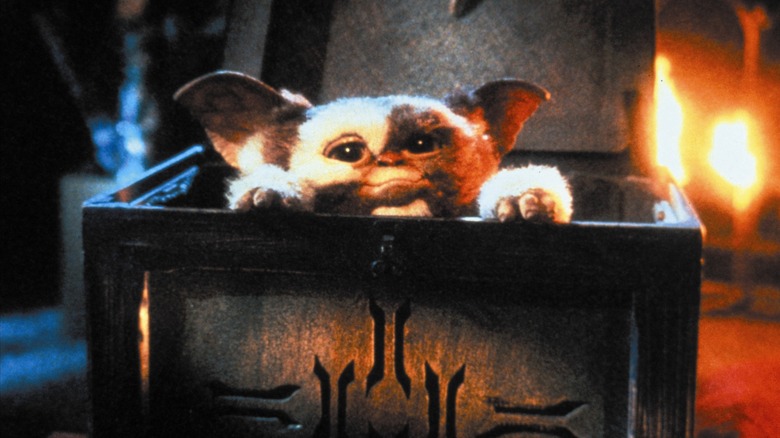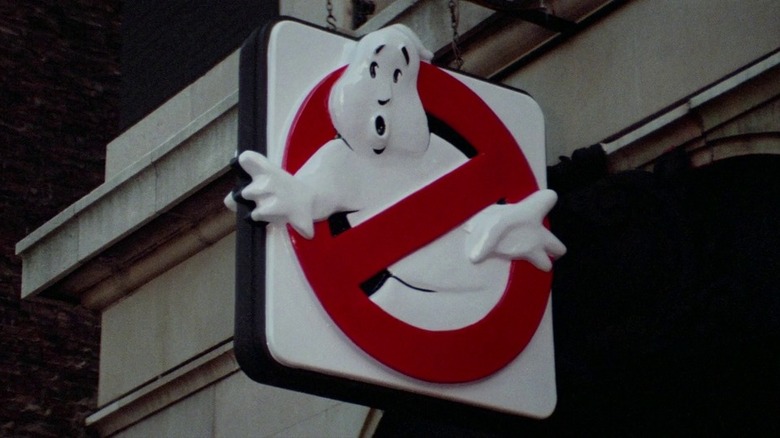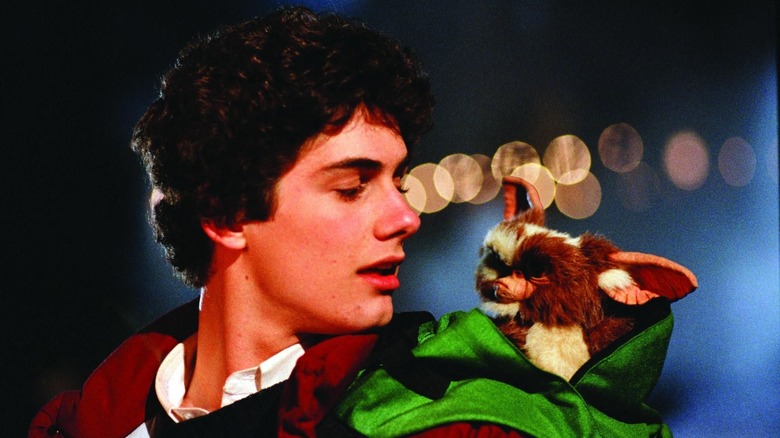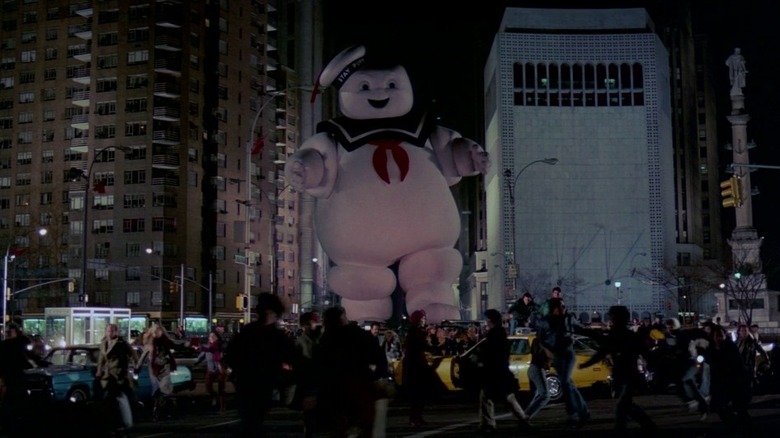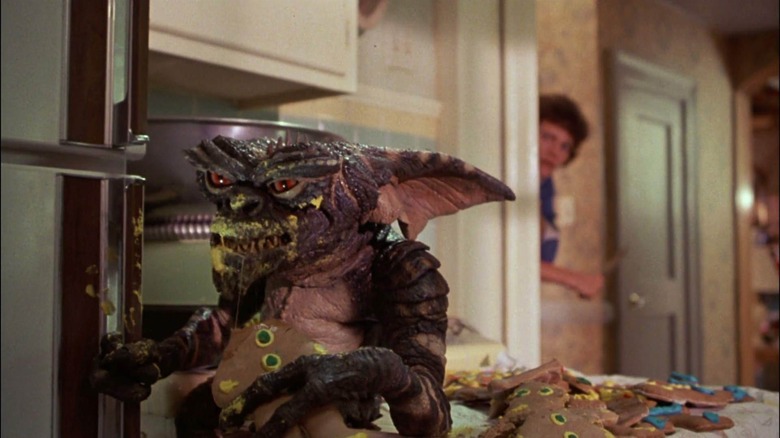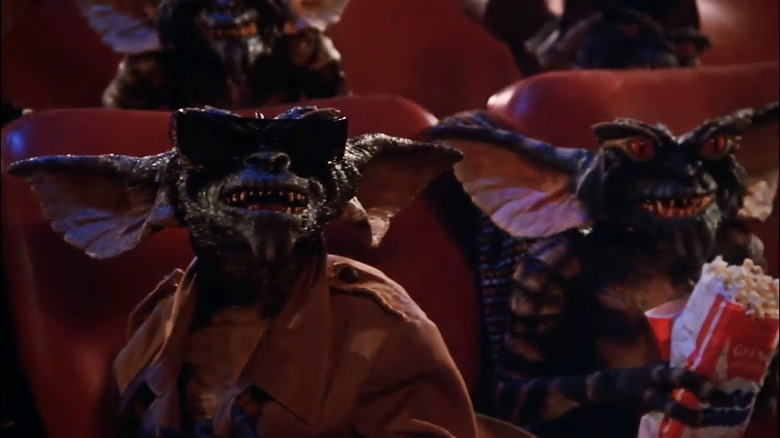40 Years Ago, Two Stone Cold '80s Classics Ruled The Box Office At The Same Time
(Welcome to Tales from the Box Office, our column that examines box office miracles, disasters, and everything in between, as well as what we can learn from them.)
1984 was a downright magical year at the movies. The number of titles released in that fateful year that have become classics is downright staggering. Wes Craven's influential horror classic "A Nightmare on Elm Street," Kevin Bacon's breakout hit "Footloose," James Cameron's masterwork "The Terminator," Steven Spielberg's second Indiana Jones adventure "Temple of Doom," and Eddie Murphy's ridiculously huge blockbuster "Beverly Hills Cop." That's truly just scratching the surface. But 40 years ago in the summer of '84, two all-time cinematic classics premiered on the very same weekend.
While it's difficult to imagine now, director Joe Dante's "Gremlins" was released against director Ivan Reitman's "Ghostbusters." It was Warner Bros. vs. Columbia Pictures, with audiences left to choose between a family-friendly creature feature produced by Steven Spielberg, or a supernatural comedy with some of the world's funniest people at its center. In the end, viewers voted resoundingly in favor of both. It resulted in one of the most remarkable double bills in cinema history, rivaled only perhaps by 2023's release of "Barbie" and "Oppenheimer" which lit the box office on fire, giving us the unforgettable summer of Barbenheimer.
In this week's Tales from the Box Office, we're looking back at the fateful weekend in 1984 when "Ghostbusters" and "Gremlins" both arrived at the exact same time. We'll go over how the films came to be, how the landscape of moviegoing was vastly different at that time, what happened when they hit theaters, how they both birthed long-running franchises and what lessons we can learn from them all these years later. Let's dig in, shall we?
The movies: Ghostbusters and Gremlins
It's worth understanding just how different the moviegoing landscape was in 1984. For one, there were far fewer theaters in the U.S., with somewhere between 18,000 and 21,000 screens across the country at that time. Remarkably, there were roughly ten times that many screens in the Soviet Union. That number is now closer to 40,000 in the U.S. The box office was also far more dependent on domestic ticket sales at that time. This was decades before Hollywood would come to depend on making sure blockbusters could play in China.
The moviegoing experience itself was also different. There were no streaming services and cable was a nascent idea. The now mostly-defunct Blockbuster Video didn't even arrive on the scene until 1985. This is to say if you wanted to see a movie, that generally happened at a theater. As for the theaters themselves? It depends on who you ask and where you lived.
"Theatres used to feel like a slightly divey bar," reads a comment on a Reddit thread about moviegoing in the '80s and '90s posted by someone under the username folstar. "You'd go there and hang around and sure it kinda sucked, but you were there, man. The people were there." On that same thread, 69ubermensch69 pointed out that "In the '80s there were ashtrays in the seats." Over on a different Reddit thread on a similar topic, user Kedosto waxed poetically about the theatrical experience of the time.
"The theater from my youth was a grand, elegant structure. It was luxurious, with lots of stained wood finishes and beautiful fabrics and carpet. The screen was behind a majestic wall of curtains which opened in a slow, regal manner. Going to the movie theater was a special event."
This is to say, be it the dive bar treatment or the special event experience, theaters were a more essential part of day-to-day life for the average person. That is crucial in looking at what happened with these two movies in their day.
The origins of Ghostbusters
The story of "Ghostbusters" begins with Dan Aykroyd, who made himself known to the world as a breakout on the early seasons of "Saturday Night Live." Aykroyd had written a script for a film originally titled "Ghost Smashers" that was, to put it mildly, vastly different from what we ended up with. Aykroyd and his family have a long history with the paranormal, which ended up influencing the film greatly.
Ivan Reitman, coming off of hits such as "Meatballs" and "Stripes," was selected to direct "Ghostbusters" and worked with Aykroyd to further develop the project. However, it was his co-star Harold Ramis who truly helped to crack the code on the script. In the original version, there were lots of Ghostbusters and the operation was already up and running. Ramis felt it would be more interesting to turn it into an origin story. Here's how he explained it in a 2005 interview:
"I thought, 'Well, it might be more interesting to take the audience through the process of how the Ghostbusters evolved, the idea of starting with us as paranormal academics, you know, at Columbia University and showing our first contact with the supernatural ... I thought, 'Well, a lot of the audience will start from a place of skepticism, and if we start the film from a place of skepticism and then bring them to belief, you know, then they'll take the trip with us.' And I think that's kind of the way it worked."
Reitman re-teamed with Bill Murray, who had also worked with Aykroyd on "SNL." The rest of the cast filled out nicely, with episodic TV actor Ernie Hudson joining as the eventual fourth Ghostbuster, while the likes of Sigourney Weaver ("Alien"), Annie Potts ("Goodtime Girls"), and Rick Moranis ("SCTV") filled in the supporting roles. The team included Aykroyd as Dr. Ray Stantz, Murray as Dr. Peter Venkman, Ramis as Dr. Egon Spengler, and Hudson as Winston Zeddmore. Columbia spent around $30 million on the production, which was a sizable budget for the time.
The origins of Gremlins
On the other side of the equation, "Gremlins" was written by Chris Columbus, who would go on to direct huge hits like "Home Alone" and the first two "Harry Potter" films. Director Joe Dante was coming off of the werewolf film "The Howling" and was very much in need of work. Steven Spielberg, who was producing the film for Warner Bros., had Dante in mind. When he first got the script, Dante "was convinced he'd sent it to the wrong address." But Spielberg had his man and the address was correct.
The film as we know it sees Billy (Zach Galligan) gifted an unusual pet by his father. This Mogwai named Gizmo is adorable but comes with a few simple rules: Keep him away from water and bright lights, and don't feed him after midnight. Naturally, the rules are broken and a small town is overrun by — you guessed it — gremlins at Christmastime. The film features impressive practical creature effects yet maintains a friendly, PG tone. Dante, however, explained in 2017 that the original script for "Gremlins" was markedly different.
"The original script was more gruesome, with Gizmo morphing into Stripe, the bad gremlin. But then Spielberg had the brilliant idea, which I think makes the picture remembered today, not to turn him into a monster but to have him carried around in the backpack of the hero Billy [Zach Galligan], like in a 'boy and a dog' movie."
With Phoebe Cates ("Fast Times at Ridgemont High") co-starring, things came together nicely once Spielberg – bringing his "E.T." sensibilities to the project — cracked the code. Warner Bros. spent $11 million on the film which was a whole lot more at the time, but still not all that expensive in the grand scheme of things. Despite heavy competition from some comedy titans, it would prove to be money well spent.
The financial journey
Columbia and Warner Bros. respectively released "Ghostbusters" and "Gremlins" in theaters on June 8, 1984. Both launched massive marketing campaigns, with a TV trailer for "Ghostbusters" including a number for a real hotline that people could call. "Gremlins" was able to leverage Spielgerg's good name and the hopelessly adorable Gizmo to attract the general public. Interestingly enough, WB opted to go with a summer release even though it is a Christmas movie. In both cases, the campaigns worked like gangbusters, leading to a legendarily good stretch at the box office.
"Ghostbusters" topped the charts on its opening weekend with $13.5 million, but "Gremlins" was close behind with $12.5 million. Reitman's supernatural comedy remained at number one for eight out of its first nine weekends, with Dante's PG creature right on its tail in the number two spot for its first six weekends. "Ghostbusters" didn't have to surrender the top spot until Prince's "Purple Rain" arrived in late July.
In its original release, "Ghostbusters" made an astounding $229.2 million domestically, while "Gremlins" pulled in $148.1 million. Relative to their budgets, these were absolute home runs for the studios. Adjusted for inflation, in today's dollars, these films would have made around $691 million and $446 million. The Barbenheimer of its day, to be certain. But these movies did it on half as many screens, which makes it all the more impressive. Not to mention that both movies enjoyed such consistent, sustained success at the exact same time. It's nothing shy of astounding to consider in the world we live in now.
To date, "Ghostbusters" has made $296.5 million worldwide thanks to its various re-releases. Because international numbers were harder to come by in those days, there's no real telling how much "Gremlins" has made overseas. That said, it has amassed $153.6 million domestically alone. In both cases, these were just the beginnings of something much bigger.
Not one but two new franchises are born
One thing that was true in the '80s, much as it is now, is that Hollywood will seek to further capitalize on any success in any way possible. As such, both of these films ended up starting franchises that are still going strong to this day. "Ghostbusters" is now a $1 billion franchise thanks to the release of this year's "Ghostbusters: Frozen Empire," the fifth film in the series overall. We've also had several animated shows, video games, and countless merchandise over the years.
As for "Gremlins," Dante returned to direct 1990's "Gremlins 2: The New Batch," which is perhaps one of the most insane sequels ever made. It was also far more expensive, with a budget said to be as high as $50 million. Unfortunately, it wasn't nearly as big of a hit, taking in just $41.4 million. The sequel has, however, garnered a cult following. That's probably why "Gremlins 3" had a hard time ever getting off the ground. But the franchise returned in the animated series "Gremlins: Secrets of the Mogwai" in 2023, which Dante says might as well be "Gremlins 3." Again, the amount of merchandise centered around these films over the years is immeasurable.
Adjusted for inflation, "Ghostbusters" is probably the highest-grossing comedy of all time. That gets tricky when accounting for inflation and when mixing genres, but it's up there. "Gremlins," similarly, is probably the biggest family-friendly horror movie ever made. Even divorced from the enduring, larger franchises they created, that's an impressive legacy that these films leave behind. For either of these movies to accomplish such a thing would be remarkable. The fact that they did it at the exact same time? Unbelievable.
The lessons contained within
So much of what pop culture is trying to do in the 2020s (and for the last decade or so) is attempting to recapture what was going on in the '80s. Part of why these movies succeeded, aside from not having Netflix or smartphones to distract us, is that "Ghostbusters" and "Gremlins" were the groundbreakers, not movies trying to emulate what was once groundbreaking. It's a reminder that new ideas are needed, even if they can be a tough sell in the modern marketplace.
Both are also rare examples of horror/comedy done right, albeit in radically different ways. We are looking at two of the best the genre has ever produced, with a select few such as Edgar Wright's "Shaun of the Dead" in the mix as well. They maintain respect for both genres at once. It's insanely difficult to do but when these genre mashups fail, it often seems to be because one of the genres has to take a backseat. These things can only truly work when the horror and the comedy are given ample time to shine.
More than anything, it's a reminder of just how essential the art of counterprogramming can be. These movies didn't run over one another because they both had something different to offer, even though they played in broadly similar genres. In the post-pandemic landscape, we haven't had nearly enough successful counterprogramming. Instead, we get movies like "The Batman" that can rule the box office unchecked for far too long. Good counterprogramming is essential to the long-term health of the industry.
These movies also played long enough to allow audiences to catch up with them. It didn't come down to a single weekend. Granted, the marketplace conditions were radically different, but rushing movies to VOD doesn't help motivate people to head to a theater. Odds are, lots of people saw both "Ghostbusters" and "Gremlins." Today, the average moviegoer would probably see one or the other – if that. That's why Barbenheimer felt so special, and that's why this fateful weekend in '84 seems so special in hindsight as well.
